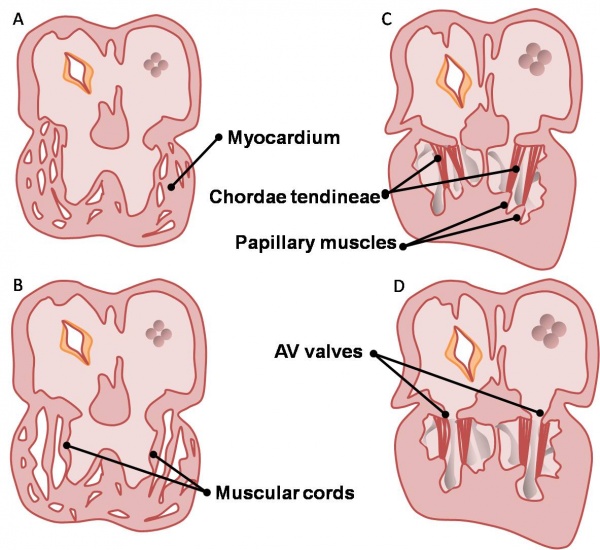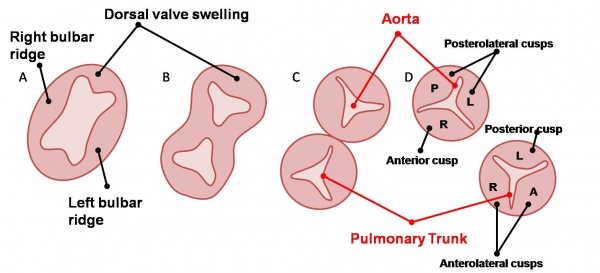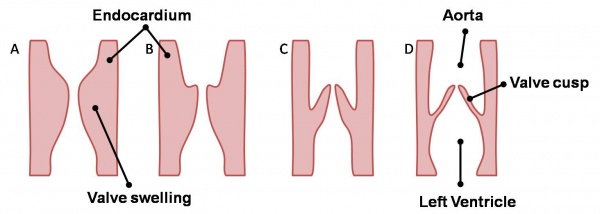Talk:Intermediate - Heart Valves: Difference between revisions
No edit summary |
No edit summary |
||
| Line 1: | Line 1: | ||
--[[User:Z3212774|Phoebe Norville]] 11:39, 2 October 2009 (EST) | --[[User:Z3212774|Phoebe Norville]] 11:39, 2 October 2009 (EST) | ||
[[Image:HeartILP_draft_avvalves.jpg|thumb|center]] | {|style="float:left" | ||
|- | |||
|[[Image:HeartILP_draft_avvalves.jpg|thumb|upright=2]] | |||
|- | |||
|[[Image:HeartILP_draft_mitraltricuspid.jpg|thumb|center|upright=2|Development of the mitral and tricuspid valves]] | |||
|} | |||
{|style="float:right" | |||
|- | |||
|[[Image:HeartILP_semilunarabove.jpg|thumb|center|upright=2|Development of the semilunar valves]] | |||
|- | |||
|[[Image:HeartILP_draft_semilunarlongitudinal.jpg|thumb|upright=2|Development of the semilunar cusps]] | |||
|} | |||
The AV valves begin to form between the fifth and eighth weeks of development. The valve leaflets are attached to the ventricular walls by thin fibrous chords, the chordae tendineae, which insert into small muscles attached to the ventricle wall, the papillary muscles. These structures are sculpted from the ventricular wall. The left AV valve has anterior and posterior leaflets and is termed the bicuspid or mitral valve. The right AV valve has a third, small, septal cusp and thus is called the tricuspid valve. These concepts are depicted on the left. | |||
The aortic and pulmonary valves, termed the semilunar valves, are formed from the bulbar ridges and subendocardial valve tissue. The primordial semilunar valve consists of a mesenchymal core covered by endocardium. Excavation occurs, thinning the valve tissue thus creating its final shape (see right). These valves form the four valves of the adult heart, depicted below. | |||
[[Image:HeartILP_draft_adultvalves.jpg|thumb|center|Adult Heart Valves]] | [[Image:HeartILP_draft_adultvalves.jpg|thumb|center|upright=2.5|Adult Heart Valves]] | ||
Revision as of 14:44, 5 October 2009
--Phoebe Norville 11:39, 2 October 2009 (EST)
The AV valves begin to form between the fifth and eighth weeks of development. The valve leaflets are attached to the ventricular walls by thin fibrous chords, the chordae tendineae, which insert into small muscles attached to the ventricle wall, the papillary muscles. These structures are sculpted from the ventricular wall. The left AV valve has anterior and posterior leaflets and is termed the bicuspid or mitral valve. The right AV valve has a third, small, septal cusp and thus is called the tricuspid valve. These concepts are depicted on the left.
The aortic and pulmonary valves, termed the semilunar valves, are formed from the bulbar ridges and subendocardial valve tissue. The primordial semilunar valve consists of a mesenchymal core covered by endocardium. Excavation occurs, thinning the valve tissue thus creating its final shape (see right). These valves form the four valves of the adult heart, depicted below.



